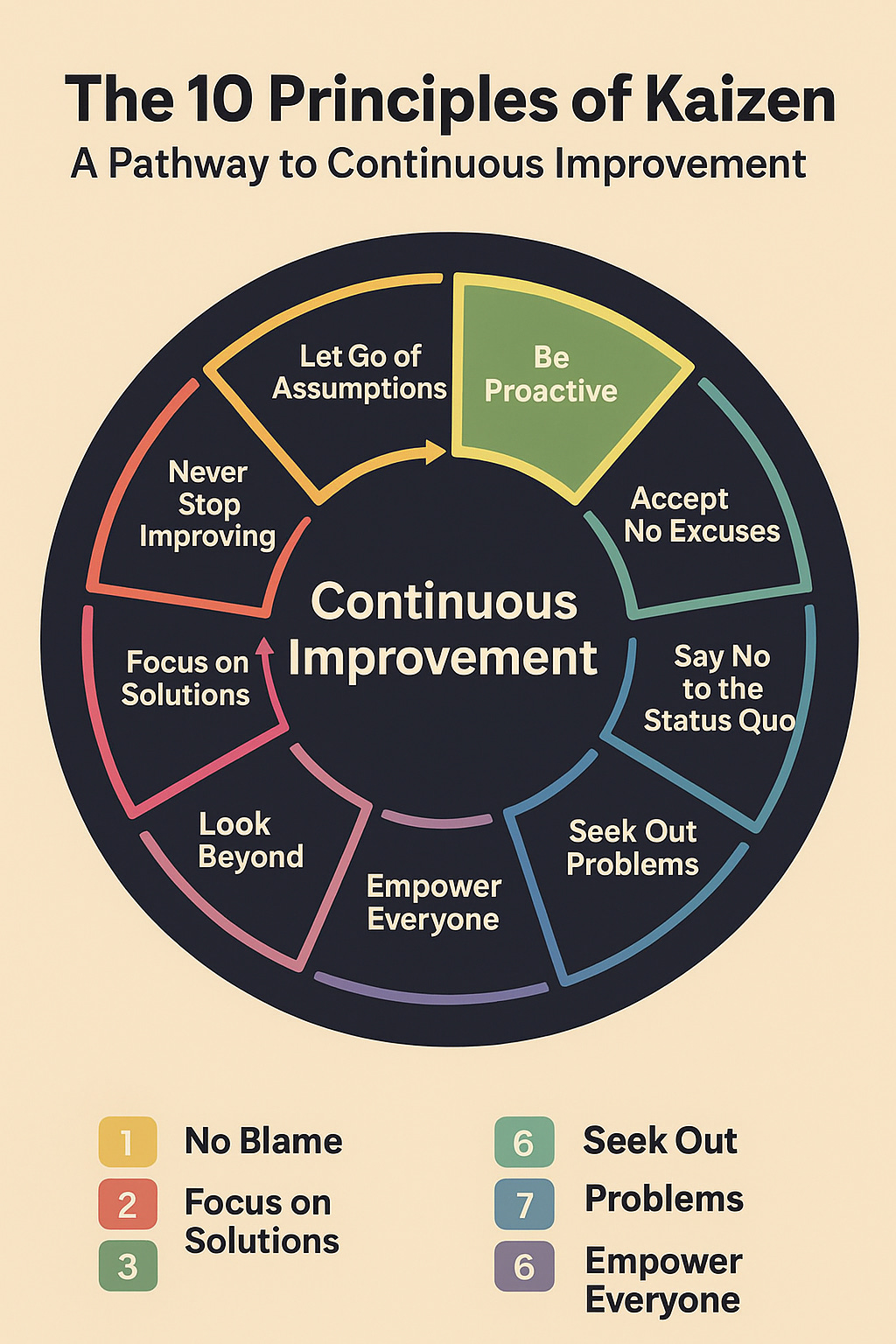The 10 Principles of Kaizen: A Pathway to Continuous Improvement
Introduction: The Spirit of Kaizen
In today’s rapidly changing world, success belongs to those who constantly evolve. Kaizen, a Japanese philosophy meaning “change for better,” teaches us that continuous improvement — no matter how small — leads to lasting transformation. It’s not about overnight success but the steady pursuit of excellence.
These 10 Principles of Kaizen, as outlined by Eric Partaker, form a practical guide for personal, professional, and organizational growth. Let’s explore how these principles can help you cultivate a mindset of ongoing improvement.
1. Let Go of Assumptions
Question Everything You Think You Know
Assumptions can limit innovation. The first step to improvement is to challenge what you believe to be “the best way.” Ask yourself: Is there a better method? Could this process be simplified or enhanced?
By letting go of assumptions, you open the door to creativity, experimentation, and progress.
2. Be Proactive
Don’t Wait — Take Initiative
Improvement doesn’t happen by chance. It requires proactive action. Instead of waiting for problems to escalate, seek them out and solve them early.
Being proactive means taking ownership, anticipating challenges, and addressing them head-on before they become major setbacks.
3. Accept No Excuses
Focus on Overcoming, Not Avoiding
Excuses build barriers to growth. A Kaizen mindset embraces accountability — focusing on how to make things happen rather than why they can’t.
When obstacles arise, look for creative solutions instead of reasons to quit. Improvement happens when excuses disappear.
4. Say No to the Status Quo
Challenge Comfort and Convention
It’s human nature to cling to the familiar. But the status quo is the enemy of progress. Kaizen teaches us to question existing systems and find better alternatives.
Growth requires courage — the courage to change, to adapt, and to innovate beyond what’s comfortable.
5. Seek Out Problems
Turn Problems into Opportunities
Problems aren’t roadblocks; they’re opportunities in disguise. Those who practice Kaizen actively look for issues, because every problem solved brings you one step closer to excellence.
By identifying and addressing small issues early, you prevent larger crises later.
6. Empower Everyone
Build a Culture of Participation
Continuous improvement isn’t a solo act. It thrives in environments where everyone feels valued and encouraged to contribute ideas.
When people are empowered to suggest changes, innovation multiplies. A true Kaizen culture treats every individual as a problem-solver.
7. Look Beyond the Obvious
Dig Deeper to Find Root Causes
Problems often lie beneath the surface. Kaizen encourages you to go beyond what’s visible and explore the deeper “why” behind every issue.
By investigating root causes instead of treating symptoms, you create lasting solutions that prevent recurrence.
8. Focus on Solutions
Shift Energy from Problems to Possibilities
It’s easy to dwell on what’s wrong — but progress happens when you focus on what can be done.
Think in terms of how instead of why not. This positive shift in mindset fuels creativity and problem-solving, key ingredients for sustained growth.
9. No Blame
Fix the System, Not the People
Blame stifles innovation and trust. In a Kaizen culture, the focus is on understanding the problem, not assigning fault.
Instead of asking “Who did this?”, ask “What went wrong and how can we fix it?” This builds a psychologically safe environment where people feel free to experiment and learn.
10. Never Stop Improving
Progress is a Journey, Not a Destination
Kaizen is an ongoing process. There’s no final finish line — only the next improvement.
Whether it’s refining a habit, optimizing a system, or enhancing a product, there’s always room to grow. Continuous improvement is what keeps individuals and organizations relevant in a changing world.
The Continuous Loop of Progress
The 10 Principles of Kaizen remind us that excellence isn’t achieved overnight — it’s built daily, step by step.
By embracing curiosity, collaboration, accountability, and persistence, we create a cycle of learning and progress that never ends.
When you live by Kaizen, improvement becomes a natural way of life — one small, meaningful step at a time.



